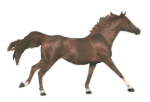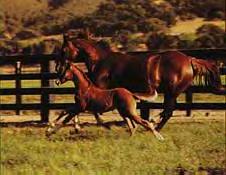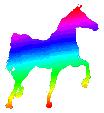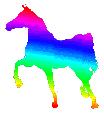My Love For Horses





INTRODUCTION Horse, common name for hoofed,
herbivorous mammals that include the domestic
horse and three groups of undomesticated species.
One group comprises the zebra, native to Africa;
another consists of the ass, including the kiang
and onager of Asia and the wild ass of Africa. The
third group contains Przewalski's wild horse,
which is now found only in captivity. The only
extant true wild horse, it produces fertile
offspring when crossed with the domestic horse.
Other so-called wild horses in various parts of
the world, such as the mustang in North America,
are descendants of domestic horses that have
reverted to a wild state.
IIPREHISTORIC HORSES The evolution of the horse
can be traced through fossil remains to the
Hyracotherium, originally identified as the
Eohippus: a small, leaf-browsing mammal of the
Eocene Epoch, 55 million to 38 million years ago.
Hyracotherium, about the size of a fox, had four
toes on its forefeet and three on its hind feet.
Several species and related genera appeared in
North America and Eurasia during the Eocene. Then,
apparently, the Eurasian species died out, but the
American species gave rise in the Oligocene Epoch,
38 million to 24 million years ago, to the genus
Mesohippus.
In the Miocene Epoch, 24 million to 5 million
years ago, Mesohippus was succeeded by Hypohippus
and Anchitherium. Both of these genera probably
migrated to Eurasia from North America. Other
descendants of Mesohippus were Miohippus and
Merychippus; the latter genus developed high-
crowned teeth, permitting it to feed by grazing on
grass rather than browsing on leaves. Among the
descendants of Merychippus in the Pliocene Epoch
were Hipparion, which apparently spread from North
America to Eurasia, and Pliohippus, which appears
to be the progenitor of the modern genus Equus,
which includes the domestic horse.
During the Pleistocene Epoch, which began 1.6
million years ago, the genus Equus apparently
spread from North America to Eurasia, Africa, and
South America. Subsequently, the native American
horses died out, possibly as a result of disease.
Cave dwellings in Europe indicate that horses were
plentiful on that continent during the early Stone
Age (about 2 million years ago to about 4000 BC).
Dismembered skeletons of horses have been found in
sufficient numbers in and near Stone Age dwellings
to show that horses were frequently killed and
eaten. In Neolithic times (about 4000 BC to 2000
BC), when Europe was largely forested, the number
of horses evidently declined. Remains of the
Bronze Age (about 1000 BC) include bits and pieces
of harness, which clearly demonstrate that horses
had become domestic animals in this period.
IIIMODERN HORSES The most marked anatomical
characteristic of the modern horse is the
possession of a single toe on each of its four
feet, which makes it a perissodactyl, or odd-toed
ungulate, along with the rhinoceros and tapir. The
horse's toe, which corresponds to the middle digit
of the human hand, is much enlarged and protected
by a horny hoof that surrounds the front and sides
of the toe. Vestigial splints corresponding to the
second and fourth toes are situated on either side
of the foot above the hoof.
The skull of the horse is long; the facial bones
are twice the length of the cranium. The mandible,
or lower jaw, is long and has a broad, flat plate
at its lower hind end. The spine is composed of 7
cervical, 18 dorsal, 6 lumbar, 5 sacral, and 15
caudal vertebrae. Horses have 44 teeth: 3
incisors, 1 canine, 4 premolars, and 3 molars on
each side of each jaw. The incisors, which are
used for cropping grass and other herbage, grow in
the form of a semicircle. A pronounced gap exists
between the canine teeth and the premolars; the
metal bit used for controlling a horse is placed
in this gap when the animal is ridden or driven.
All the teeth have long crowns and comparatively
short roots. The horse has a simple stomach, and
fermentation of fibrous food takes place in a
blind pocket, or cecum, analogous to the appendix
in humans. It is located at the juncture of the
small and large intestines. In a large horse the
cecum may have a capacity of about 38 liters
(about 10 gallons).
Both male and female horses are sexually mature by
the age of two. They are seldom used for breeding
purposes, however, before they are three years
old. The gestation period is about 11 months, and
single births are the rule. Twins are a genuine
rarity, and only a few births of three or more
foals have ever been recorded.
IVGAITS Horses are capable of a wide range of
gaits; a few of them are artificially developed by
trainers. For simplicity they may be divided into
symmetrical gaits, in which equal time intervals
separate the touching of the ground by the left
and right front legs (and also by the left and
right hind legs); and asymmetrical gaits, in which
the time intervals are not equal. Familiar
symmetrical gaits, in order of increasing speed,
include the walk, pace, and trot. A horse walks by
swinging its legs in the order of left front,
right rear, right front, and left rear. It paces
winging the left and then the right legs nearly in
on, and trots by swinging the diagonally opposite
nearly in unison. Artificial symmetrical gaits
ude the slow gait, or stepping pace, and the
er rack, or single-foot, both of which are done
legs lifted high and no more than two legs on the
nd at the same time. Asymmetrical gaits include
er and the faster gallop, in which the left and
,he right hind leg touches the ground, followed by
left and then the right front leg; the sequence
be reversed right to left.
DS AND BREEDS Domestic horses were introduced into
lonia in about 2000 BC and into Egypt about 300
s later. The animals were brought into Egypt by
Hyksos from northeastern Syria. These Egyptian and
lonian horses were the forerunners of the swift
Arabian and related desert breeds of the Middle
East and northern Africa. Another strain of horses
was domesticated in Europe. Heavily built and
slower but more powerful than the desert breeds,
they are regarded as the early ancestors of the
modern draft horses used for plowing, pulling
wagons, and other heavy work. Some authorities
also believe that a third ancestral strain found
in the British Isles was the prototype of various
breeds of modern ponies.
Throughout most of Europe, from the early
centuries AD to about the 17th century, the
powerful native horses were used for military
mounts, for hauling heavy loads, and as pack
animals. During the same period the Arab world had
developed smaller, fast-galloping breeds, which
were introduced into Spain after the Muslim
conquest in the 8th century. The horses bred in
Spain became famous for their speed and endurance
and many were imported into England and Europe as
early as the 12th century. Systematic attempts to
improve extant breeds of horses, however, did not
take place until the end of the 17th century, when
Arabian stallions were imported to England and
France to breed with mares of native stock.
The first domestic horses introduced into the
Americas were of the Arabian type, brought by the
Spanish conquistadores and explorers in the 16th
century. They are believed to have lost or
abandoned some of their horses, and these animals
may have been the source of herds of wild horses
found in various parts of western North America.
Horses left by the Spanish also ran wild on the
pampas of South America around the Río de la
Plata. The English settlers, especially the early
Virginia colonists, also imported horses.
In the last 300 years horse breeders have made
continuous attempts to improve the various breeds
of horses and to develop strains that are
particularly suited for specialized tasks. The
resultant new breeds include saddle horses and
harness horses especially adapted for racing
gaits, hunters adapted for endurance, carriage
horses and draft horses for pulling heavy loads,
and cattle horses, ponies, and polo ponies (small,
fast animals that can be trained to the
complicated maneuvers of roping or the game of
polo).
The Arabian breed is often divided into three
subbreeds: Turks from European Turkey and Asia
Minor, Arabians from the regions between Damascus
and the Euphrates River, and Barbs from the
Barbary states of northern Africa. Arabians in
general are comparatively small horses, standing
between 147 and 152 cm (58 and 60 in) at the
withers (the high part of the back, located
between the shoulder blades), or 15 hands high.
The height of a horse is frequently given in
hands, one hand-the width of a human hand-is equal
to 10 cm (4 in). Arabians have remarkable powers
of endurance and are swift gallopers. All the
saddle breeds are derived, in large part, from
Arabian stock.
The Thoroughbred was developed in the early 18th
century from offspring of three foundation sires-
the Byerly Turk, the Darley Arabian, and the
Godolphin Barb-and native English mares. It is
primarily used for flat-track racing, hunting, and
jumping. The American standardbred, developed in
the northeastern United States in colonial times,
is a light harness type and is most often used in
trotting or pacing races. Biologically speaking,
saddle horses are more properly types than breeds.
Because of the popularity of various equestrian
sports and activities, registry and breed
associations have been established for such
important show and racing horses as the American
saddle horse, the Tennessee walker, the Morgan,
and the quarter horse. Saddle horses weigh much
less than draft horses.
The breeds of draft horses are more distinct than
those of saddle horses. They include the Belgian
heavy draft horse, the English shire, the
Clydesdale, and the Percheron. The Belgian is one
of the largest of horses, reaching a shoulder
height of 173 cm (68 in) or more and weights of as
much as 1125 kg (2500 lb). The English shire is
about the same size, but has long hair on the back
of its hind legs from its hooves up to the hock (a
joint corresponding to the human ankle, but
bending backwards). These breeds represent
refinements of the original horses of their
countries of origin. The Clydesdale, smaller than
the above breeds, was developed in Scotland by
crossing native horses with Belgian heavy draft
horses and the English shire. The Percheron, which
stands about 168 cm (66 in) at the shoulder, is a
native of the former district of Le Perche in
northwestern France and was produced by crossing
Arabian horses with the old Flemish breed of which
the Belgian heavy draft horse is the modern
representative.
Ponies are identified as those breeds which stand
less than 152 cm (60 in) or 15 hands high. The
real differences between ponies and larger horses,
however, are size and action. The body of a pony
is deeper in relation to its height than that of a
horse, and a pony usually is more sure-footed than
a horse. Many ponies are native to Great Britain:
the Dartmoor, the Exmoor, and the Welsh mountain
pony for instance. The smallest of the ponies is
the Shetland, which is only about 106 cm (about 42
in) high at the withers.
Scientific classification: Horses belong to the
family Equidae of the order Perissodactyla. The
domestic horse is classified as Equus caballus.
Przewalski's wild horse is classified as Equus
caballus przewalskii.
See also Horsemanship; Horse Racing.
Further Reading
"Horse," Microsoft® Encarta® Encyclopedia 99. ©
1993-1998 Microsoft Corporation. All rights
reserved.








 
|